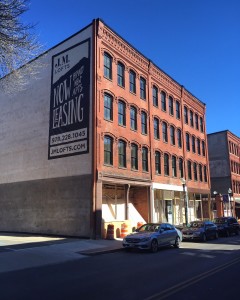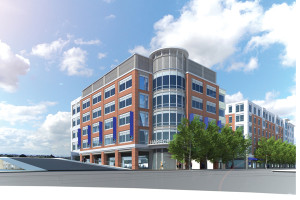Along The Merrimack, Repopulating A Downtown
Haverhill Mill Buildings Converted Into Housing
March 27, 2016 : Banker & Tradesman, by Jay Fitzgerald
For 45 years, the old Woolworth building in downtown Haverhill sat vacant, a decades-long eyesore and reminder that the old mill city along the Merrimack River had seen better days.
But later this year, construction of the new Harbor Place – a two-building, mixed-use complex costing $70 million – is expected to conclude on the site of the recently demolished Woolworth building. Once completed, Harbor Place will have 80 mixed-income rental units, 15,000 square feet of ground-floor retail space, more than 50,000 square feet of commercial space for tenants including UMass-Lowell and Pentucket Bank – and a boardwalk that will provide pedestrian access to the river for the first time since before World War II.
“This is a pretty extraordinary development that’s acted as a trigger for other projects in the downtown,” said Lisa Alberghini, president of the nonprofit Planning Office for Urban Affairs Inc., co-developer of Harbor Place along with the nonprofit Greater Haverhill Foundation.
Indeed, there’s a lot going on these days in Haverhill, one of 26 officially designated Gateway Cities across Massachusetts.
Boston-based Traggorth Cos. LLC is putting the finishing touches on the J.M. Lofts project on the site of a former shoe factory at 45 Washington St. in the heart of Haverhill’s downtown. J.M. Lofts, which is expected to open later this spring, will include 18 rental units and 4,000 square feet of ground-floor retail.
Three other major mixed-use projects are awaiting final approvals in or around the downtown: the redevelopment of the old Haverhill Music Center on Washington Street (12 residential units and retail); the Chen building on Essex Street (59 rental units and retail); and the Gerson furniture building on Washington Street (43 units and perhaps retail).
 |
| Traggorth Cos. is converting a vacant former shoe factory in the heart of downtown Haverhill into 18 loft-style apartments. |
And Haverhill Mayor James Fiorentini said he plans to soon announce two more major development projects in Haverhill, though he declined to give details about them before Banker & Tradesman’s deadline.
All of this is on top of the hundreds of other residential units recently built in Haverhill, a new parking garage near the Haverhill commuter rail station and an influx of new restaurants and shops that have recently opened to enliven the downtown.
“We’ve seen a lot of changes in Haverhill,” Fiorentini said. “Living downtown is the cool thing to do these days.”
A Bus Tour Led To An Opportunity
So what happened in Haverhill, known as the “Shoe City,” to make all of this possible? Officials say a combination of factors have coalesced at the right time for Haverhill, a once-mighty industrial town along the New Hampshire border. Statewide demand for multifamily housing is improving. Developers are looking for less expensive areas to build outside Greater Boston. Local communities are embracing transit-oriented development and welcoming housing near transit stops such as Haverhill’s MBTA commuter rail station.
Developer David Traggorth said his firm had never done a project before in Haverhill – and probably wouldn’t have if MassDevelopment, the state finance and development agency, hadn’t provided a tour for Boston developers to see opportunities in various Gateway Cities.
On the bus tour of Haverhill, Traggorth spotted a building for sale, and in 2013 his firm purchased the former 20,000-square-foot shoe factory at 45 Washington St.
Many of the Haverhill projects, like Traggorth’s J.M. Lofts, involve federal and state tax credits aimed at spurring construction of affordable housing, often tied to the preservation of historic mills and other buildings. In the case of J.M. Lofts, the old brick and beam building required a “total gut rehab,” said Traggorth. “It’s a gorgeous building,” he said. The complex is marketing one-bedroom units with monthly rents starting at under $1,400.
Many of the projects also receive assistance via the state’s Gateway Cities program, designed to promote economic development in former industrial cities like Haverhill, population 60,000.
One contribution is MassDevelopment’s Transformative Development Initiative (TDI), which assigns “fellows” to Gateway Cities to help with economic development. Noah Koretz, a TDI fellow, is working on projects just outside Haverhill’s downtown area, where many older buildings were demolished decades ago as a result of what many today consider misguided “urban renewal” policies in the 1960s and 1970s.
Koretz said he’s in talks with a number of potential developers.
“We have a lot of positive momentum in the city,” he said. “It’s a good city to do business in.”
Haverhill’s existing businesses and business groups are largely ecstatic about the changes underway in their city.
“It feels like, for the first time in a while, we can look forward and see progress,” said Stacey Bruzzese, president of the Greater Haverhill Chamber of Commerce.
© Copyright 2016 Banker & Tradesman.


